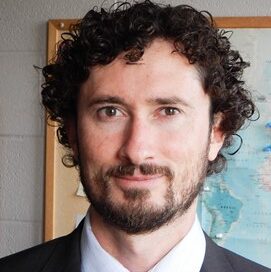8 marketing lessons from the 2016 Notre Dame CMO Summit
Published: November 1, 2016 / Author: Christine Cox

What does it take to be an effective chief marketing officer in an increasingly complicated world? Speakers from GE, Google, Spotify and other companies gave their best insights at the first Notre Dame CMO Summit on September 29 and 30. With a theme of “Meaningful Marketing,” the event drew 150 attendees to the Mendoza College of Business.
Here are 8 takeaways.
1. Show up in unexpected ways
“Any time we can show up in a way that is a delightful surprise — to be human, to be humorous, sometimes to be a little self-deprecating — we reintroduce the company.”
— Linda Boff, GE Chief Marketing Officer
Examples: Commercials about Owen, the young GE developer; reinvented moon sneakers; the Breakthrough television series
2. Start internally
“In marketing, you can run the risk of just trying to get the work out and hitting deadlines. But you have to ask, ‘What’s my associate strategy?’ … It makes for a really strong culture. So a huge part of my role is making sure we’re connecting with our associates [coworkers] as much as with our external audience.”
— Denise Karkos (ND Marketing ’93), TD Ameritrade Chief Marketing Officer
Examples: Associates’ internal commercial for the Olympic games; bringing in company-sponsored athletes to speak to their associates and families
3. Be useful
“A finite resource that we all have [is] our time. So how can our marketing — while it may aspire to emotional connections — how can it be useful? What are brands’ opportunities to really be useful in our lives? Recent research shows consumers are more interested in brands that are useful than brands that are interesting.”
— Margaret Molloy, Siegel+Gale Chief Marketing Officer
4. Navigate the fine line between sophistication and complication
“Just because it can be done doesn’t mean it should be done. Complication gets ugly and people get bogged down. Sophistication creates excitement and elicits all the brain waves to connect and all the synapses to get people moving forward. … [Understand] what you’re trying to accomplish and then feed everything into that.”
— Mark Flaharty (ND ’90), SundaySky Chief Operating Officer of Advertising
5. Respect privacy
“The three pillars still matter, regardless of demographic or region: transparency, utility and control. Consumers need to know and be able to find what do you [as a brand] know about me; what are you doing with that [information]; and how do I benefit from it? And can I control it? Consumers need to be able to opt in and opt out; dial things up, dial things down [in a relationship with a brand].”
— Jim Lecinski (ND ’87), Google Managing Director of U.S. Sales
6. Understand the true sources of competitive advantages
“We’ll ask somebody, what is your brand or your company’s competitive advantage? And you’ll get a list. You can’t have a list. You can’t have that many competitive advantages unless you’re a monopoly. If you can come up with one or two, then you truly have an advantage business.”
— Rick Lenny, IRI Board Chairman
7. Don’t forget the human element
“Organizations are fundamentally data rich and insight poor. … If you have all this data but you’re not grinding it in all sorts of ways, I’m not sure you’re going to get to this next great insight. You have to have some form of energy that is going to create those hypotheses. The human element to me in marketing is very important. … It’s ironic that people want to hand off the big decisions in marketing to machines. At the end of the day, it’s your call.”
— Tony Pace (ND ’79), Cerebral Graffiti Founder
8. Achieve diversity to generate empathy
“You have to have a very diverse team in every single way. You have to hire people with different points of view. GAP [his former workplace] was like a UN convention. The person who ran advertising was from Costa Rica, the person who ran events was from India. We thought about it in a way of inviting all these points of view so we could have a [high] level of empathy [for our customers].”
— Seth Farbman, Spotify Chief Marketing Officer




